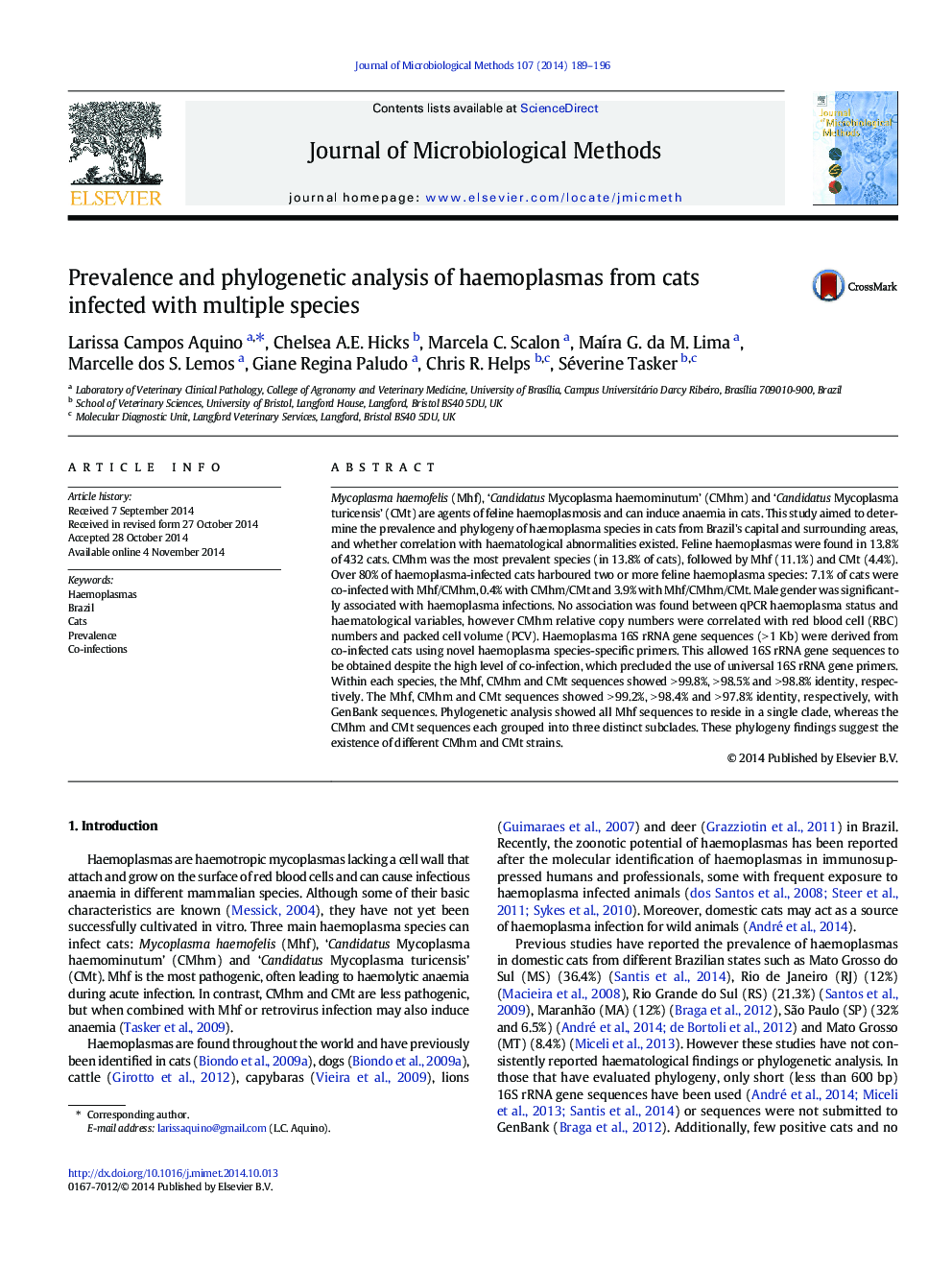| کد مقاله | کد نشریه | سال انتشار | مقاله انگلیسی | نسخه تمام متن |
|---|---|---|---|---|
| 8421970 | 1545936 | 2014 | 8 صفحه PDF | دانلود رایگان |
عنوان انگلیسی مقاله ISI
Prevalence and phylogenetic analysis of haemoplasmas from cats infected with multiple species
ترجمه فارسی عنوان
بررسی شیوع و فیلوژنتیک هموپلازها از گربه های آلوده به گونه های مختلف
دانلود مقاله + سفارش ترجمه
دانلود مقاله ISI انگلیسی
رایگان برای ایرانیان
کلمات کلیدی
هموپلاسما، برزیل، گربه شیوع، عفونت های مشترک،
موضوعات مرتبط
علوم زیستی و بیوفناوری
بیوشیمی، ژنتیک و زیست شناسی مولکولی
بیوتکنولوژی یا زیستفناوری
چکیده انگلیسی
Mycoplasma haemofelis (Mhf), 'Candidatus Mycoplasma haemominutum' (CMhm) and 'Candidatus Mycoplasma turicensis' (CMt) are agents of feline haemoplasmosis and can induce anaemia in cats. This study aimed to determine the prevalence and phylogeny of haemoplasma species in cats from Brazil's capital and surrounding areas, and whether correlation with haematological abnormalities existed. Feline haemoplasmas were found in 13.8% of 432 cats. CMhm was the most prevalent species (in 13.8% of cats), followed by Mhf (11.1%) and CMt (4.4%). Over 80% of haemoplasma-infected cats harboured two or more feline haemoplasma species: 7.1% of cats were co-infected with Mhf/CMhm, 0.4% with CMhm/CMt and 3.9% with Mhf/CMhm/CMt. Male gender was significantly associated with haemoplasma infections. No association was found between qPCR haemoplasma status and haematological variables, however CMhm relative copy numbers were correlated with red blood cell (RBC) numbers and packed cell volume (PCV). Haemoplasma 16S rRNA gene sequences (>Â 1Â Kb) were derived from co-infected cats using novel haemoplasma species-specific primers. This allowed 16S rRNA gene sequences to be obtained despite the high level of co-infection, which precluded the use of universal 16S rRNA gene primers. Within each species, the Mhf, CMhm and CMt sequences showed >Â 99.8%, >Â 98.5% and >Â 98.8% identity, respectively. The Mhf, CMhm and CMt sequences showed >Â 99.2%, >Â 98.4% and >Â 97.8% identity, respectively, with GenBank sequences. Phylogenetic analysis showed all Mhf sequences to reside in a single clade, whereas the CMhm and CMt sequences each grouped into three distinct subclades. These phylogeny findings suggest the existence of different CMhm and CMt strains.
ناشر
Database: Elsevier - ScienceDirect (ساینس دایرکت)
Journal: Journal of Microbiological Methods - Volume 107, December 2014, Pages 189-196
Journal: Journal of Microbiological Methods - Volume 107, December 2014, Pages 189-196
نویسندگان
Larissa Campos Aquino, Chelsea A.E. Hicks, Marcela C. Scalon, MaÃra G. da M. Lima, Marcelle dos S. Lemos, Giane Regina Paludo, Chris R. Helps, Séverine Tasker,
